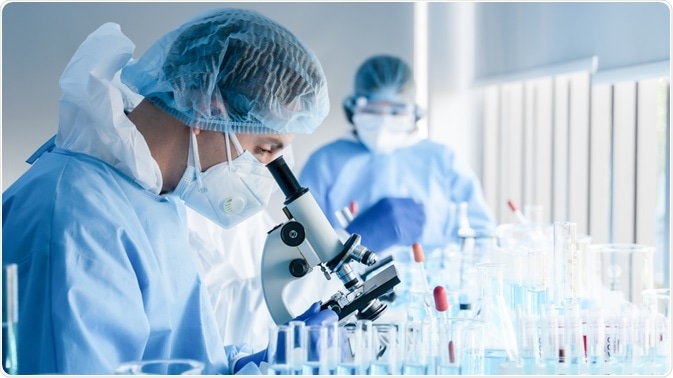Microbes are too small to see with the naked eye, being nano in scale. There is an intersection between nanotechnology and biology, and cutting-edge research in both fields has led to the development of new scientific disciplines that deal with the nanoscale. This article will discuss one such scientific field, nano microbiology.

Image Credit: Mongkolchon Akesin/Shutterstock.com
The importance of studying microbial cells
Over the last 50 years, the importance of the microbial cell surface in medicine, ecology, industry, and biology has become increasingly recognized. A microbe’s cell surface has several functions for the organism: it protects the cytoplasm, imparts shape, supports the organism’s internal pressure, acts as a molecular sieve, controls cell adhesion and molecular recognition, and is the target of antibiotics.
These characteristics have several major consequences for biotechnology, industrial processes, medicine, and microbiology. New developments are needed to probe microbial surfaces, providing vital information on the structure, interaction, and properties of microbes and how this can be utilized in the development of new medicines, chemicals, and industrial processes.
Scanning electron microscopy (SEM) and transmission electron microscopy (TEM) have traditionally been used for this purpose, but there are significant drawbacks to using these techniques to study microbes. Cryo-methods have shown some success in allowing researchers to explore the natural views of bacterial cell envelopes, but these methods are not widely used and require significant sample preparation and analysis.
Electron microscopy approaches can provide useful information on cell surfaces such as composition, interaction, and properties. Additionally, biochemical analysis, surface analysis methods, and biophysical techniques are utilized by researchers. However, these methods require significant sample preparation and generally provide averaged information gathered from large amounts of cells. The drawbacks of all these methods require the development of new techniques.
Nano microbiology: Science at the nano frontier
Nano microbiology exists at the crossroads of biology and nanoscience. It is an exciting, rapidly evolving field of research made possible by the development of atomic force microscopy (AFM). Nano microbiology gives researchers the power to study cell membranes and live cells in unprecedented detail.
Atomic force microscopy works by scanning a sample’s surface with a very sharp tip. The tip senses near-physical reactions between the sample and the tip, generating three-dimensional images. These images are generated directly in an aqueous solution. AFM has advantages over other microscopy techniques including minimizing sample preparation and topographic characterization of surfaces at resolutions not possible with optical microscopy.
AFM makes possible visualization of cell and membrane surfaces at subnanometer resolution. Conformational changes of membrane proteins can be observed and related to function. Time-lapse imaging helps investigators follow dynamic events that occur at the cell surface, such as microbe-drug interactions, something that electron microscopy lacks. Nanoscale studies in microbiology provide new insights and avenues for areas such as biomedicine, nanobiology, and environmental biology.
Structural imaging
Thanks to improvements in equipment design, sample preparation methods, and recording conditions, the resolution of structures has shown significant progress. Membrane proteins can be resolved in the range of 0.5-1nm. Two-dimensional crystals of native membranes and membrane proteins are well-suited for AFM imaging and manipulation. Structural information and function-related conformational changes in membrane proteins can be visualized.
AFM has also been used to reveal the ultrastructure of non-crystalline native membranes. Studies have been carried out on various photosynthetic bacteria including Rhodobacter sphaerodes, Rhodopseudomonas viridis, and Rhodospirillum photometricum. New insights into the supramolecular organization of membrane protein complexes have been made possible How photosynthetic membranes of R. photometricum respond to light have been elucidated with nano microbiology.
Researching live cells with nano microbiology
Studying whole cells can present unique challenges to researchers using AFM. Difficulties exist with sample preparation and imaging conditions. Isolated membranes are easier to immobilize than whole cells. The cells can be dried out or bonded to supports covalently, but this causes problems such as denaturation, contamination, and rearrangement of cell walls. This provides inaccurate information on the natural state of the cell.
Despite these issues, AFM is increasingly being used to study structural details of hydrated cells. Some bacteria that have been studied include lactic acid bacteria, Pinnularia viridis, and Bacillus spores. Real-time imaging of live cells is revolutionizing our understanding of cell surface dynamics. For example, high-resolution images of fungal spores have revealed surface architecture changes during germination. Cell line growth and division events in S. aureus have been observed using AFM and TEM.
Drug-induced alterations of surface roughness on hydrated mycobacteria have been observed using nano microbiology techniques. One factor that aids live cell analysis is the non-invasive nature of techniques. In the future, this will increase understanding of the mechanisms of the cell wall assembly and the action mode of antibiotics, to name but a couple of important areas of research for medical research.
Fields that will benefit from nano microbiology
Nano microbiology, along with the related fields of nanobiotechnology and nanobiology, is beneficial to several industries. Research will help develop improvements in drug design, drug delivery, and inform the design of nanoscale devices. This will provide new, tailored applications for the biomedical and life sciences fields, industrial microbiology, environmental remediation, and many other industries crucial for human development in the 21st century.
Summing up
Nano microbiology is an exciting field that has evolved rapidly over the past couple of decades. By exploring microbial cells at the nanoscale, information about their function and properties will help to inform a wide range of research beneficial to multiple industries. This discipline is truly at the frontiers of science in the 21st century.
References:
Further Reading
Last Updated: Nov 22, 2021